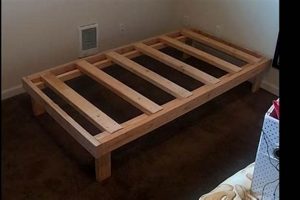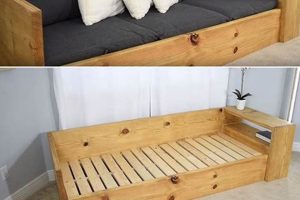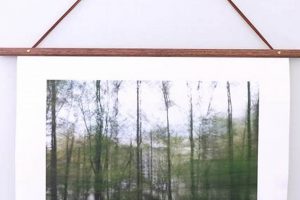A basic weaving device, easily constructed from readily available materials, provides an accessible entry point into the textile arts. An example includes a rectangular structure fashioned from wood, cardboard, or even a picture frame, fitted with evenly spaced warp threads to create a surface for interlacing weft yarns.
Such a device facilitates the creation of woven tapestries, wall hangings, and small fabric pieces. The simple construction allows for experimentation with various textures, colors, and weaving techniques, fostering creativity and resourcefulness. Historically, similar frame-based looms have enabled individuals to produce textiles for personal use, fostering self-sufficiency and artistic expression.
The following discussion will address construction methods, warping techniques, and basic weaving patterns applicable to these handcrafted tools.
Construction and Use
The following provides practical advice for constructing and effectively utilizing a basic weaving frame.
Tip 1: Secure Frame Construction: Ensure the frame possesses robust joints. Weak joinery can lead to instability, potentially affecting warp tension and the overall quality of the woven piece.
Tip 2: Even Warp Spacing: Maintain consistent spacing between warp threads. Use a notched template or ruler during the warping process to guarantee uniformity, preventing uneven fabric texture.
Tip 3: Appropriate Warp Tension: The warp should be taut, but not excessively so. Overly tight warp threads can lead to frame distortion, while insufficient tension can result in loose and uneven weaving.
Tip 4: Weft Yarn Selection: Choose weft yarns appropriate for the desired texture and appearance. Thicker yarns create a more pronounced texture, while finer yarns produce a smoother fabric.
Tip 5: Consistent Weaving Tension: Maintain a uniform tension while passing the weft through the warp. Inconsistent tension can lead to puckering or distortion of the finished fabric.
Tip 6: Edge Management: Employ techniques to prevent edges from pulling inwards. This can be achieved by periodically adjusting the weft angle or by using edge weights.
Tip 7: Experimentation with Texture: Explore diverse weaving techniques to create varied textures. Incorporate rya knots, soumak weaves, or looped textures to add visual interest.
Adherence to these guidelines will contribute to the creation of structurally sound and aesthetically pleasing woven pieces.
The concluding section will summarize the key aspects of building and utilizing the described device for textile creation.
1. Frame Rigidity
Frame rigidity represents a fundamental structural requirement for a functional weaving device of a basic type. Inadequate frame stability directly compromises the ability to maintain consistent warp tension, a critical factor in producing even and structurally sound woven fabric. For instance, a frame constructed from thin, flexible cardboard may bow or warp under tension, leading to uneven weft placement and distortion of the final piece. Conversely, a frame built from sturdy hardwood or reinforced with corner braces offers superior resistance to deformation, enabling the creation of consistently tensioned warp threads and a uniform weave.
The impact of frame rigidity extends beyond basic weave structure. Complex patterns, involving variations in weft density or the incorporation of supplementary warp threads, demand even greater structural stability. Consider tapestry weaving, where areas of concentrated weft density can exert significant pressure on the frame. A rigid frame distributes this pressure evenly, preventing localized warp distortion and ensuring the integrity of the tapestry design. Similarly, the use of heavier or textured yarns requires a robust frame to withstand the increased tension, preventing frame failure and preserving the intended aesthetic.
Understanding the importance of frame rigidity is therefore crucial for successful textile creation. Selecting appropriate materials and construction techniques directly influences the quality and longevity of the weaving device. Moreover, addressing potential weaknesses through reinforcement or design modifications enhances the reliability and versatility. Consequently, attention to frame rigidity becomes an essential prerequisite for creating durable and aesthetically pleasing woven textiles.
2. Warp Tension
Warp tension represents a foundational element in weaving, and its precise management is particularly crucial when utilizing a basic weaving frame. Inherent limitations in adjustability and stability inherent in such devices necessitate a thorough understanding of tension’s influence on the final woven product.
- Consistent Yarn Properties
Uniformity in warp yarn thickness and elasticity is paramount. Variations in these properties directly translate to uneven tension distribution across the warp. For example, using a blend of yarns with differing fiber compositions can result in some threads stretching more than others, leading to puckering or sagging in the woven fabric. Therefore, selecting a single type of yarn with consistent properties is highly recommended.
- Warping Method Impact
The technique used to wind the warp threads onto the frame significantly affects tension. Manual warping, often employed with homemade frames, demands meticulous attention to ensure each thread is uniformly tensioned. A common error involves uneven winding pressure, resulting in some threads being significantly tighter than others. Utilizing a warping board, if available, can aid in achieving more consistent tension.
- Frame Design Constraints
Simple weaving frames often lack sophisticated tensioning mechanisms found on more advanced looms. The absence of adjustable tension bars or ratchets requires careful initial setup. Over-tensioning the warp can distort or even break the frame, while insufficient tension leads to loose and unstable weaving. A balanced approach, achieving tautness without excessive strain, is essential for successful operation.
- Influence on Fabric Quality
Warp tension directly determines the structural integrity and aesthetic appearance of the woven fabric. Consistent tension promotes a uniform weave structure, resulting in a flat, even surface. Conversely, uneven tension can cause distortions, such as rippling or diagonal lines. Furthermore, inconsistent tension compromises the durability of the fabric, making it more susceptible to tearing or unraveling.
The interplay between these facets underscores the critical role of warp tension in crafting textiles with a basic weaving frame. Mastery of tension management, through careful yarn selection, precise warping techniques, and mindful frame operation, is essential for achieving high-quality results and unlocking the potential of this accessible weaving method. Experimentation with different materials and techniques, while carefully monitoring the resulting tension, is recommended for refining skills and achieving desired aesthetic outcomes.
3. Weft Selection
Weft selection, referring to the choice of materials used for the horizontal threads in weaving, exerts a substantial influence on the characteristics of fabrics produced on a basic weaving frame. This aspect is particularly significant given the limitations of such devices, where nuanced adjustments common to more sophisticated looms are absent. Consequently, careful material consideration is paramount.
- Yarn Fiber Type and Texture
The fundamental material composition and surface characteristics of the weft yarn directly determine the fabric’s tactile qualities and visual appearance. Natural fibers, such as cotton or wool, impart softness and absorbency, suitable for items like dishcloths or blankets. Conversely, synthetic fibers, such as acrylic or polyester, offer increased durability and water resistance, making them applicable for items subject to wear or outdoor exposure. Textured yarns, incorporating slubs, loops, or other surface irregularities, introduce visual and tactile depth, creating fabrics with a more pronounced aesthetic.
- Yarn Weight and Density
The thickness and density of the weft yarn impact the fabric’s drape and insulation properties. Thicker yarns produce denser fabrics with increased warmth and rigidity, suitable for outerwear or upholstery. Finer yarns result in lighter, more pliable fabrics with enhanced drape, appropriate for garments or lightweight coverings. The choice of yarn weight must align with the intended use of the woven material to achieve desired performance characteristics.
- Color and Pattern Integration
Weft yarns offer a primary avenue for introducing color and pattern into woven fabrics. Solid-colored weft threads create a uniform background, allowing warp colors or structural patterns to take precedence. Variegated or self-striping yarns introduce subtle color gradations and visual interest. By strategically alternating weft colors or employing specific weaving techniques, intricate patterns can be developed, ranging from simple stripes and checks to complex geometric designs. The selection of weft colors and patterns must complement the overall aesthetic intent of the woven piece.
- Functional Properties and Durability
The weft yarn contributes significantly to the functional properties and overall durability of the fabric. High-tensile strength yarns, such as linen or nylon, improve the fabric’s resistance to tearing and abrasion, extending its lifespan. Resistance to shrinkage, fading, and pilling are also factors to consider, particularly for items intended for frequent use or washing. The choice of weft yarn should reflect the anticipated wear and tear the fabric will endure, ensuring its longevity and continued performance.
The aforementioned elements highlight the substantial influence of weft selection on the performance and appearance of textiles crafted using basic weaving frames. While these frames offer simplicity and accessibility, judicious material choices are imperative to maximize the potential of this weaving method and produce high-quality, functional, and aesthetically pleasing woven products.
4. Edge Control
Edge control, referring to techniques employed to maintain a straight and even selvage in woven fabric, presents a significant challenge when using a basic weaving frame. The inherent limitations of these devices, particularly the absence of sophisticated tensioning and take-up mechanisms, necessitate proactive measures to prevent edge draw-in and ensure dimensional stability.
- Weft Angle Management
The angle at which the weft yarn is inserted into the warp directly impacts edge stability. A weft thread laid perfectly perpendicular to the warp tends to pull the edges inwards, resulting in a narrowing fabric. To counteract this, the weft should be inserted at a slight angle, forming a gentle arc. The precise angle varies depending on the yarn type and tension, requiring experimentation to achieve optimal results. Consistently managing this angle throughout the weaving process is crucial for maintaining straight edges.
- Looping Techniques
Creating small loops at the edges of the fabric can effectively prevent draw-in. As the weft yarn reaches the edge, it is looped around the outermost warp thread before returning in the opposite direction. This technique adds extra yarn at the edges, compensating for the natural tendency to constrict. The size of the loops should be consistent and adjusted based on the fabric’s behavior. Looping is particularly beneficial when working with yarns that exhibit high elasticity or a strong tendency to pull.
- Edge Weighting
Attaching weights to the edges of the warp threads can provide additional tension and prevent draw-in. Small, evenly spaced weights, such as metal washers or clothespins, are clipped onto the outermost warp threads. The weight applied should be sufficient to counteract the pull of the weft yarn but not so excessive as to distort the frame. Edge weighting is particularly useful when working with wide fabrics or when employing complex weaving patterns that exert uneven tension on the warp.
- Selvage Reinforcement
Reinforcing the selvage edges with a stronger or more rigid yarn can provide added stability. This involves incorporating a supplementary warp thread or a tightly twisted cord along the edges of the fabric. The reinforcement thread acts as an anchor, preventing the weft from pulling the edges inwards. Selvage reinforcement is particularly advantageous when creating fabrics that will be subjected to significant stress or wear along the edges, such as tapestries or rugs.
The interplay of these edge control techniques underscores their importance in achieving successful outcomes with a basic weaving frame. By proactively managing weft angle, employing looping techniques, utilizing edge weights, and reinforcing the selvage, the dimensional stability and overall aesthetic appeal of woven fabrics can be significantly enhanced. These strategies mitigate the limitations inherent in simple frame looms, enabling the creation of professional-looking textiles despite the constraints of the equipment.
5. Texture Variation
Texture variation in textiles produced on a basic weaving frame constitutes a significant avenue for creative expression and functional adaptation. The inherent simplicity of these looms necessitates a deliberate approach to manipulating weft and warp interactions to achieve diverse tactile and visual surfaces.
- Yarn Weight and Ply Manipulation
Altering yarn weight and ply directly impacts the fabric’s surface texture. Employing thicker yarns or multiple strands creates a more pronounced, raised texture, suitable for items requiring enhanced tactile interest or insulation. Conversely, finer yarns produce a smoother, flatter surface conducive to drape and detail. Strategic combinations of yarn weights and plies can yield nuanced textures within a single woven piece, adding depth and complexity to the design.
- Weave Structure Alterations
Deviations from basic plain weave offer diverse textural possibilities. Techniques such as rib weave, twill weave, or variations of soumak create distinctive surface patterns and tactile sensations. Rib weave, for instance, produces horizontal ridges, adding dimension and structure. Soumak variations, involving wrapping weft threads around warp threads, create raised, textured lines or patterns. These structural alterations introduce visual and tactile interest beyond the flatness of plain weave.
- Supplementary Weft Inclusions
Introducing supplementary weft elements allows for the creation of pronounced textures and three-dimensional effects. Techniques such as rya knotting, incorporating loops of yarn that extend from the fabric surface, create a shaggy or pile-like texture. Inserting small pieces of fabric, ribbon, or other materials into the weft creates layered textures and visual depth. These inclusions provide opportunities for highly individualized and expressive textural embellishments.
- Surface Finishing Techniques
Post-weaving finishing processes can further enhance textural variations. Brushing the fabric surface raises fibers, creating a softer, more napped texture. Fulling, a process involving washing and agitating the fabric, shrinks and compacts the fibers, resulting in a denser, more felted texture. Selective application of heat or pressure can create localized textural changes, adding dimension and visual interest. These finishing techniques offer a means to refine and customize the final texture of the woven piece.
The integration of these diverse texture variation techniques with a basic weaving frame provides a readily accessible means for creating textiles with enhanced aesthetic and functional properties. The deliberate manipulation of yarn characteristics, weave structures, supplementary inclusions, and surface finishes allows for the creation of unique and expressive woven pieces, transcending the limitations of the simple equipment.
6. Design Complexity
The level of design complexity achievable with a basic weaving frame is inherently limited by the device’s simple construction and manual operation. The absence of automated mechanisms for shedding, picking, and beating necessitates a deliberate and methodical approach to pattern creation. Complex patterns, involving intricate color changes, elaborate weave structures, or the incorporation of supplementary warp or weft elements, demand significant time, skill, and meticulous attention to detail. The practical effect of this limitation is that while ambitious designs are theoretically possible, their execution requires considerable dedication and expertise. For example, replicating a complex tapestry design on a simple frame, which might be swiftly accomplished on a Jacquard loom, becomes a labor-intensive undertaking, highlighting the trade-off between accessibility and intricate design capability. Understanding this constraint is crucial for setting realistic expectations and selecting appropriate projects for the medium.
Despite these limitations, significant design complexity can still be realized through strategic use of basic techniques. Simple geometric patterns, such as stripes, checks, and chevrons, are readily achievable by alternating weft colors or manipulating warp arrangement. More advanced patterns can be created by employing supplementary warp or weft floats, creating textured surfaces and visual interest. Furthermore, the incorporation of non-traditional materials, such as beads, feathers, or found objects, can add layers of complexity and personalization to the design. A practical example is the creation of a stylized landscape tapestry using different colors and textures of yarn to represent various elements, such as mountains, trees, and water, demonstrating that creativity and ingenuity can overcome the constraints of the equipment. Careful planning and experimentation are essential for maximizing design potential within the context of a frame loom.
In summary, the relationship between design complexity and the described device is characterized by inherent limitations that demand careful consideration and strategic adaptation. While intricate and highly detailed designs may prove challenging to execute, the device’s accessibility and affordability make it an ideal platform for exploring basic weaving techniques and experimenting with a range of textures and colors. Understanding the capabilities and limitations of the frame allows weavers to make informed design choices, fostering creativity and producing satisfying textile projects despite the simplicity of the equipment. The primary challenge lies in balancing ambitious design aspirations with the practical constraints of the weaving process, emphasizing the importance of patience, skill, and a realistic assessment of achievable outcomes.
Frequently Asked Questions
The following addresses common inquiries regarding the construction, operation, and capabilities of basic weaving frames.
Question 1: What materials are most suitable for constructing a durable basic weaving frame?
Hardwoods, such as maple or oak, offer superior rigidity and longevity for frame construction. Alternatively, thick plywood or reinforced cardboard can provide a cost-effective option. The primary requirement is structural stability to withstand warp tension.
Question 2: How does warp tension affect the outcome of a woven piece created on a basic weaving frame?
Consistent and appropriate warp tension is critical for even fabric structure. Insufficient tension results in loose and uneven weaves, while excessive tension can distort the frame or break warp threads. Maintaining balanced tension is essential for producing quality textiles.
Question 3: What techniques can be employed to prevent edge draw-in when weaving on a basic frame?
Managing the weft angle, incorporating looping techniques at the edges, and utilizing edge weights are effective methods for preventing edge draw-in. These techniques compensate for the lack of sophisticated tensioning mechanisms in basic frames.
Question 4: Is it possible to create complex patterns on a basic weaving frame, or is it limited to simple designs?
While limited by the manual operation of these frames, intricate patterns can be achieved through strategic color changes, supplementary warp or weft techniques, and careful planning. Simplicity of the equipment demands higher skill and time investment for complex designs.
Question 5: What types of yarn are best suited for weaving on a basic frame, and how does yarn choice affect the final product?
Yarn selection significantly impacts the texture, drape, and durability of the fabric. Natural fibers offer softness and absorbency, while synthetic fibers provide increased strength and water resistance. Yarn weight and ply influence the fabric’s density and insulation properties.
Question 6: How can texture variation be achieved on a basic weaving frame, given its inherent simplicity?
Varying yarn weights and plies, altering weave structures, incorporating supplementary weft inclusions, and applying surface finishing techniques provide avenues for creating diverse textures. These methods compensate for the lack of automated texture-generating mechanisms.
Mastery of these principles allows individuals to fully leverage the capabilities of basic weaving frames and produce quality textiles.
The concluding section will offer a summary of key considerations for utilizing basic weaving frames effectively.
diy frame loom
This exploration has addressed the construction, use, and limitations of a basic weaving device. Effective utilization relies on understanding frame rigidity, warp tension management, weft selection criteria, edge control techniques, and methods for introducing texture variation. Design complexity, while constrained by the device’s manual operation, can be enhanced through strategic planning and skill development.
Continued experimentation and refinement of technique remain essential for realizing the full potential of this accessible form of textile creation. Further research into advanced weaving methods and material innovations may broaden the scope of possibilities achievable with handcrafted weaving devices.







